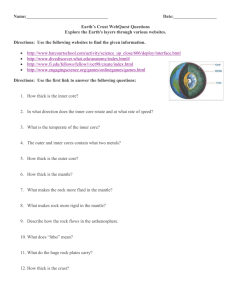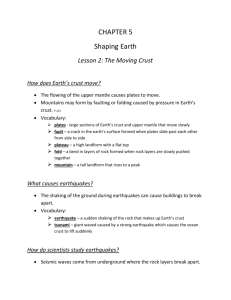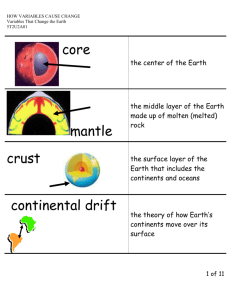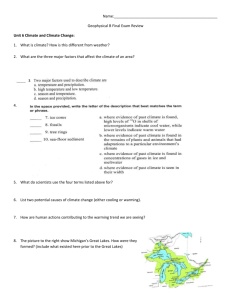File
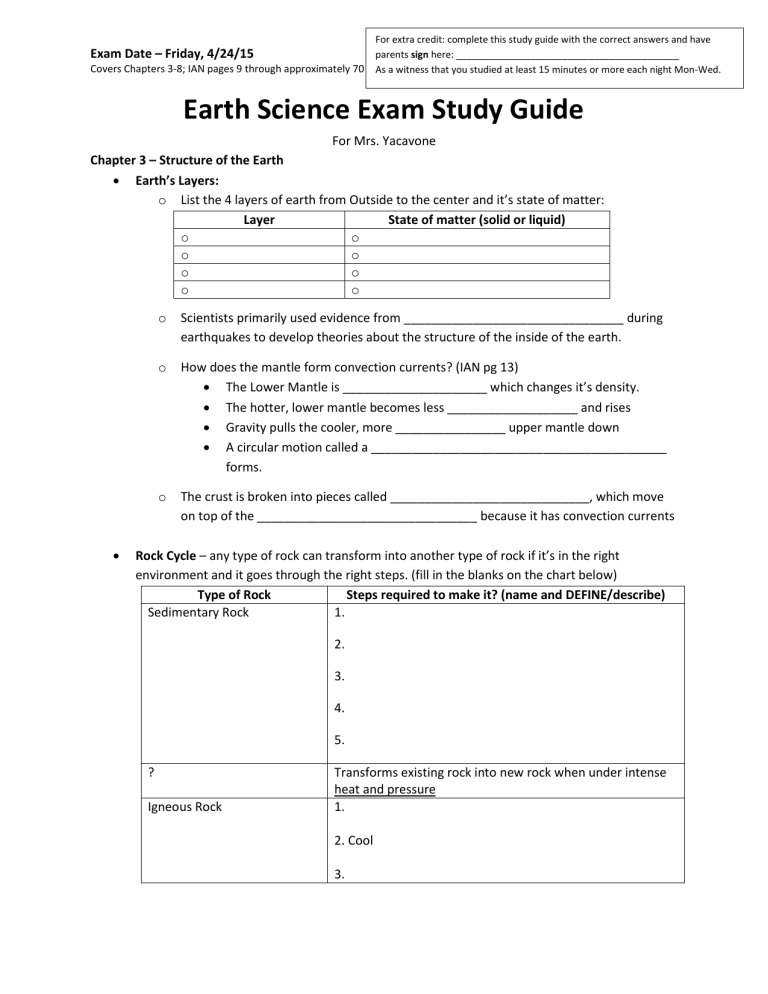
Exam Date – Friday, 4/24/15
Covers Chapters 3-8; IAN pages 9 through approximately 70
For extra credit: complete this study guide with the correct answers and have parents sign here: __________________________________________
As a witness that you studied at least 15 minutes or more each night Mon-Wed.
Earth Science Exam Study Guide
For Mrs. Yacavone
Chapter 3 – Structure of the Earth
Earth’s Layers: o List the 4 layers of earth from Outside to the center and it’s state of matter: o o
Layer o o
State of matter (solid or liquid) o o o o o Scientists primarily used evidence from ________________________________ during earthquakes to develop theories about the structure of the inside of the earth. o How does the mantle form convection currents? (IAN pg 13)
The Lower Mantle is _____________________ which changes it’s density.
The hotter, lower mantle becomes less ___________________ and rises
Gravity pulls the cooler, more ________________ upper mantle down
A circular motion called a ___________________________________________ forms. o The crust is broken into pieces called _____________________________, which move on top of the ________________________________ because it has convection currents
Rock Cycle – any type of rock can transform into another type of rock if it’s in the right environment and it goes through the right steps. (fill in the blanks on the chart below)
Type of Rock
Sedimentary Rock 1.
Steps required to make it? (name and DEFINE/describe)
2.
3.
4.
5.
?
Igneous Rock
Transforms existing rock into new rock when under intense heat and pressure
1.
2. Cool
3.
Exam Date – Friday, 4/24/15
Covers Chapters 3-8; IAN pages 9 through approximately 70
Chapter 4 Earth’s History
___________________________ - the preserved remains or traces of ancient organisms o 6 types: molds, casts, trace, carbon-film, preserved remains, petrified fossils
__________________________________________ – the collection of fossils found and studies by scientists in order to gather information about the history of life on earth and past environments. o We have learned the following from this record:
The history of life on earth and what species have gone ________________
The evolution of life on earth
Past environments or climates on earth
Ages of Rocks o __________________________ Age – comparing the age of a rock to another rock
The following rules apply to determining this type of rock age: the Law of
Superposition, intrusions, extrusions, unconformities, and faults o __________________________ Age – the actual number of years since the rock formed
_____________________ measures the time it takes for half of the radioactive element in the rock to break down into a stable element. Monitoring this radioactive decay and entering these and other measurements in a formula allows scientists to calculate the rock’s actual age.
Chapter 5 Plate Tectonics
The Theory of ____________________________________ improved upon Wegener’s hypothesis of Continental Drift because it explained HOW ______________________________.
This theory states that the earth’s crust is broken into _________________________ that are in
______________________________ caused by _______________________________________ in the mantle.
Scientific data shows that the plates move an average of _______ to _______ centimeters per year, which is about how much your fingernails grow in one year. o Evidence to support this Theory includes:
Wegener’s evidence of Continental Drift: puzzle-like fit, ________________,
Climate, ____________________________
Sea-floor Spreading – caused by ______________________________________ moving the plates and pulling apart a divergent boundary
Pillow lava
____________________________ - how the magnetic minerals were distributed evenly on both sides of the mid-ocean ridge.
Ages of the Rocks on both sides of the ridge
Exam Date – Friday, 4/24/15
Covers Chapters 3-8; IAN pages 9 through approximately 70
Chapter 7 Earthquakes
Stress builds up in the rock layers as the tectonic plates move. This build-up of stress causes
____________________ to form.
When the rocks slip or break during tectonic plate movement, vibrations, called ____________
_______________ travel through the earth. The shaking and trembling of the rock layers that results from these vibrations is known as an _________________________________.
Too much stress can lead to Earthquakes and strain, or the change in the _________________ or volume of the rock layers.
Scientists use a special instrument called the ____________________________________ to measure the magnitude of an earthquake.
Earthquakes occur most often along ________________________________ boundaries.
Fault
Types of Faults and related forces: (fill in the blanks on the chart below)
Boundary Movement Stress Strain
Normal
Convergent
Pulling apart/away from each other; hanging wall slides down the footwall.
Compression thinning of crust, forms rift valleys and mid-ocean ridges
Strike-Slip
_____________
Ex: California’s west coast
Sliding past horizontally in opposite directions causes earthquakes
Chapter 6 Volcanoes
A ____________________________ is a type of mountain that forms in the earth’s crust when molten material called _________________ reaches the earth’s surface.
Eruptions can be ________________ or explosive. The type of eruption is determined by the amount of ______________________ in the magma.
Many small ______________________________ near a volcano is a sign that is may erupt soon.
The pressure building-up from ______________________________________ in the magma provide the force needed to make the volcano erupt.
Most volcanoes form near the edges of the __________________________ boundaries, for ex: o At _________________________________ boundaries under the ocean, along midocean ridges because of sea-floor spreading or on the continents in a rift valley. o At ________________________ boundaries when _______________________ zones form where two pieces of oceanic crust collide, or when oceanic crust collides with continental crust. This is because the crust that is being subducted is melting and forming a hot source of magma that rises.
Exam Date – Friday, 4/24/15
Covers Chapters 3-8; IAN pages 9 through approximately 70
Ch 8 Land, Air, and Water Resources
*All living things, including humans, depend on non-living resources in the environment such as ______________, air, and ___________________ in order to survive.
*_______________________________are the main living thing responsible for polluting these renewable resources, which causes harm to themselves and to other living things.
*Pollution and destruction of habitats caused by humans is largely responsible for the increased rate of
___________________________________ of other species, meaning these species no longer exist on earth.
The *_____________________________ is a natural process that helps trap some heat from the sun in the earth’s atmosphere to maintain an average Earth temperature of 59°F. This happens because certain gases in the environment allow the sun’s heat to be trapped in the atmosphere to keep the earth warm. However, too much of a good thing can lead to bad things.
*_________________________________________ is a trend where the average overall temperature of the earth is increasing. Scientists have learned this trend is rising at a faster rate because of humans releasing greenhouse cases as a higher rate than normal. Most come from the *burning of fossil fuels in cars, factories and electricity production. *The gas responsible for the most warming is _____________________________________, also called CO
2
.
*items in the table below will be addressed on the exam
Resource Type of pollution
Causes Effects
Air Emissions burning *________ fuels to run motor vehicles, industrial factories, and coal power plants
Increases *_______ in the atmosphere, a greenhouse gas, which then forms low-lying toxic ozone
Nutrient depletion
Methane released from animals and degrading waste at landfills
Over growing Agriculture to support overpopulation which leads to a loss of nutrients in the soil and difficulty growing more plants
Increases the
*_____________effect and can cause temperature inversion desertification,
*_________________ of land
Land
Possible solutions
Ride bikes, walk, __________ use of motor vehicles and electricity; Improve processes at factories and plants to reduce emissions.
Reduce waste sent to landfills by following the 3 Rs reduce, reuse, recycle.
Crop rotation, alternating sections of land for agriculture, composting
Water
Development
Agricultural wastes
Industrial waste
Sewage
Sediments
Urbanization,
Industrialization, mining
*_______________, fertilizer or animal waste run-off into ponds and other waterways
Waste from factories pumped/dumped into waterways
Human waste from sinks, showers, toilets
Erosion from soil, construction, etc.
___________________ – reduction plants, loss of habitat and ecosystems, which can lead to the
___________________ of species
Leads to eutrophication due to increased algae, then bacteria, and eventually death of a pond-water ecosystem
Chemicals harm bodies of water and organisms in them
Increases disease-causing organisms in the water
Covers food sources, nests, eggs
Land reclamation, reduction of urbanization and industrialization
Reduce the use of fertilizers and pesticides, follow all directions carefully when used
Recycle wastes, reduce production of waste, make environmentally safe products
Increase sewage treatment to remove sewage from water
Reduce erosion by planting, plants roots hold dirt.
